Mass Balance of Maritime Glaciers in the Southeastern Tibetan Plateau during Recent Decades
Abstract
1. Introduction
2. Study Area and Methods
2.1. Maritime Glaciers
2.2. Climate of the SETP
2.3. Observations on Maritime Glaciers
2.4. Methods
3. Recent Advances in the Mass Balance of Maritime Glaciers in the SETP
4. Drivers of Maritime Glacier Mass Loss in the SETP
4.1. Glacier Mass Loss Driven by Climate Change
4.2. Glacier Mass Loss Driven by Other Factors
4.2.1. Debris Cover
4.2.2. Glacial Lakes
4.2.3. Ice Crevasses and Ice Avalanches
5. Challenges, Future Perspectives, and Recommendations for the Study of Maritime Glacier Mass Balance
5.1. Glacier Information
5.2. Monitoring Networks for Maritime Glaciers and Surroundings
5.3. Glacier Mass-Balance Modeling
6. Conclusions
Supplementary Materials
Author Contributions
Funding
Institutional Review Board Statement
Informed Consent Statement
Data Availability Statement
Conflicts of Interest
References
- Yao, T.D.; Thompson, L.; Yang, W.; Yu, W.S.; Gao, Y.; Guo, X.J.; Yang, X.X.; Duan, K.Q.; Zhao, H.B.; Xu, B.Q.; et al. Different glacier status with atmospheric circulations in Tibetan Plateau and surroundings. Nat. Clim. Chang. 2012, 2, 663–667. [Google Scholar] [CrossRef]
- Immerzeel, W.W.; Lutz, A.; Andrade, M.; Bahl, A.; Biemans, H.; Bolch, T.; Hyde, S.; Brumby, S.; Davies, B.; Elmore, A. Importance and vulnerability of the world’s water towers. Nature 2020, 577, 364–369. [Google Scholar] [CrossRef] [PubMed]
- Ding, Y.J.; Zhang, S.Q.; Wu, J.K.; Zhao, Q.D.; Li, X.Y.; Qin, J. Recent progress on studies on cryospheric hydrological processes changes in China. Adv. Water Sci. 2020, 31, 690–702, (In Chinese with English Abstract). [Google Scholar]
- Azam, M.F.; Kargel, J.S.; Shea, J.M.; Nepal, S.; Haritashya, U.K.; Srivastava, S.; Maussion, F.; Qazi, N.; Chevallier, P.; Dimri, A. Glaciohydrology of the Himalaya-Karakoram. Science 2021, 373, eabf3668. [Google Scholar] [CrossRef]
- Pritchard Hamish, D. Asia’s shrinking glaciers protect large populations from drought stress. Nature 2019, 569, 649–654. [Google Scholar] [CrossRef] [PubMed]
- Yao, T.D.; Xue, Y.K.; Chen, D.L.; Chen, F.H.; Thompson, L.; Cui, P.; Koike, T.; Lau, W.K.M.; Lettenmaier, D.; Mosbrugger, V. Recent third pole’s rapid warming accompanies cryospheric melt and water cycle intensification and interactions between monsoon and environment: Multidisciplinary approach with observations, modeling, and analysis. Bull. Am. Meteorol. Soc. 2019, 100, 423–444. [Google Scholar] [CrossRef]
- Yao, T.D.; Bolch, T.; Chen, D.L.; Gao, J.; Immerzeel, W.; Piao, S.L.; Su, F.G.; Thompson, L.; Wada, Y.; Wang, L.; et al. The imbalance of the Asian water tower. Nat. Rev. Earth Environ. 2022, 3, 618–632. [Google Scholar] [CrossRef]
- Brun, F.; Berthier, E.; Wagnon, P.; Kääb, A.; Treichler, D. A spatially resolved estimate of High Mountain Asia glacier mass balances from 2000 to 2016. Nat. Geosci. 2017, 10, 668–673. [Google Scholar] [CrossRef] [PubMed]
- Shean, D.E.; Bhushan, S.; Montesano, P.; Rounce, D.R.; Arendt, A.; Osmanoglu, B. A systematic, reigonal assessment of High Mountain Asia glacier mass balance. Front. Earth Sci. 2020, 7, 363–381. [Google Scholar] [CrossRef]
- Hugonnet, R.; McNabb, R.; Berthier, E.; Menounos, B.; Nuth, C.; Girod, L.; Farinotti, D.; Huss, M.; Dussaillant, I.; Brun, F.; et al. Accelerated global glacier mass loss in the early twenty-first century. Nature 2021, 592, 726–731. [Google Scholar] [CrossRef] [PubMed]
- Veh, G.; Korup, O.; von Specht, S.; Roessner, S.; Walz, A. Unchanged frequency of moraine-dammed glacial lake outburst floods in the Himalaya. Nat. Clim. Chang. 2019, 9, 379–383. [Google Scholar] [CrossRef]
- Ding, Y.J.; Mu, C.C.; Wu, T.H.; Hu, G.J.; Zou, D.F.; Wang, D.; Li, W.P.; Wu, X.D. Increasing cryospheric hazards in a warming climate. Earth-Sci. Rev. 2021, 213, 103500. [Google Scholar] [CrossRef]
- Zhang, T.; Wang, W.; Gao, T.; An, B.; Shang, X. Glacial lake outburst floods on the High Mountain Asia: A review. J. Glaciol. Geocryol. 2021, 43, 1673–1692, (In Chinese with English Abstract). [Google Scholar]
- Zhang, T.; Wang, W.; An, B.; Wei, L. Enhanced glacial lake activity threatens numerous communities and infrastructure in the Third Pole. Nat. Commun. 2023, 14, 8250. [Google Scholar] [CrossRef]
- Taylor, C.; Robinson, T.R.; Dunning, S.; Carr, J.R.; Westoby, M. Glacial Lake outburst floods threaten millions globally. Nat. Commun. 2023, 14, 487. [Google Scholar] [CrossRef]
- Su, Z.; Shi, Y.F. Response of monsoonal temperate glaciers to global warming since the Little Ice Age. Quatern. Int. 2002, 97, 123–131. [Google Scholar] [CrossRef]
- Shi, Y.F.; Liu, S.Y. Estimation on the response of glaciers in China to the global warming in the 21st century. Chin. Sci. Bull. 2000, 45, 668–672. [Google Scholar] [CrossRef]
- Li, J.; Zheng, B.; Yang, X.; Xie, Y.; Zhang, L.; Ma, Z.; Xu, S. Glaciers of Xizang (Tibet); Science Press: Beijing, China, 1986. (In Chinese) [Google Scholar]
- Li, J.; Su, Z. Glaciers in the Hengduan Mountains; Science Press: Beijing, China, 1996; pp. 1–282. (In Chinese) [Google Scholar]
- Yang, W.; Yao, T.D.; Xu, B.Q.; Zhou, H. Influence of supraglacial debris on summer ablation and mass balance in the 24K Glacier, southeast Tibetan Plateau. Geogr. Ann. A 2010, 92, 353–360. [Google Scholar]
- Zhang, Y.; Hirabayashi, Y.; Fujita, K.; Liu, S.Y.; Liu, Q. Heterogeneity in supraglacial debris thickness and its role in glacier mass changes of the Mount Gongga. Sci. China Earth Sci. 2016, 59, 170–184. [Google Scholar] [CrossRef]
- Zhang, Y.; Gu, J.; Liu, S.Y.; Wang, X.; Jiang, Z.L.; Wei, J.F.; Zheng, Y.J. Spatial pattern of the debris-cover effect and its role in the Hindu Kush-Pamir-Karakoram-Himalaya glaciers. J. Hydrol. 2022, 615, 128613. [Google Scholar] [CrossRef]
- Liao, H.J.; Liu, Q.; Zhong, Y.; Lu, X.Y. Supraglacial debris-cover change and its spatial heterogeneity in the Mount Gongga, 1990–2019. Acta Geogr. Sin. 2021, 76, 2647–2659, (In Chinese with English Abstract). [Google Scholar]
- Yi, S.; Song, C.Q.; Heki, K.; Kang, S.C.; Wang, Q.Y.; Chang, L. Satellite-observed monthly glacier and snow mass changes in southeast Tibet: Implication for substantial meltwater contribution to the Brahmaputra. Cryosphere 2020, 14, 2267–2281. [Google Scholar] [CrossRef]
- Zhao, F.Y.; Long, D.; Li, X.D.; Huang, Q.; Han, P.F. Rapid glacier mass loss in the Southeastern Tibetan Plateau since the year 2000 from satellite observations. Remote Sens. Environ. 2022, 270, 112853. [Google Scholar] [CrossRef]
- Luo, L.H.; Ke, C.Q.; Fan, Y.B.; Wang, Z.F. Accelerated glacier mass loss in the southeastern Tibetan Plateau since the 1970s. Adv. Clim. Chang. Res. 2023, 14, 372–386. [Google Scholar] [CrossRef]
- Zhang, Y.; Hirabayashi, Y.; Liu, Q.; Liu, S.Y. Glacier runoff and its impact in a highly glacierized catchment in the southeastern Tibetan Plateau: Past and future trends. J. Glaciol. 2015, 61, 713–730. [Google Scholar] [CrossRef]
- Zhang, Y.; Liu, S.Y.; Liu, Q.; Wang, X.; Jiang, Z.L.; Wei, J.F. The Role of Debris Cover in Catchment Runoff: A Case Study of the Hailuogou Catchment, South-Eastern Tibetan Plateau. Water 2019, 11, 2601. [Google Scholar] [CrossRef]
- Su, F.G.; Zhang, L.; Ou, T.; Chen, D.; Yao, T.D.; Tong, K. Hydrological response to future climate changes for the major upstream river basins in the Tibetan Plateau. Glob. Planet. Chang. 2016, 136, 82–95. [Google Scholar] [CrossRef]
- Wang, Y.; Wang, H.; Cui, P.; Chen, D. Disaster effects of climate change and the associated scientific challenges. Chin. Sci. Bull. 2024, 69, 286–300, (In Chinese with English Abstract). [Google Scholar]
- Cui, P.; Guo, X.J.; Jiang, T.H.; Zhang, G.T.; Jin, W. Disaster Effect Induced by Asian Water Tower Change and Mitigation Strategies. Bull. Chin. Acad. Sci. 2019, 34, 1313–1321, (In Chinese with English Abstract). [Google Scholar]
- Chen, C.; Zhang, L.M.; Xiao, T.; He, J. Barrier Lake bursting and flood routing in the Yarlung Tsangpo Grand Canyon in October 2018. J. Hydrol. 2020, 583, 124603. [Google Scholar] [CrossRef]
- An, B.S.; Wang, W.C.; Yang, W.; Wu, G.J.; Guo, Y.H.; Zhu, H.F.; Gao, Y.; Bai, L.; Zhang, F.; Zeng, C.; et al. Process, mechanisms, and early warning of glacier collapse-induced river blocking disasters in the Yarlung Tsangpo Grand Canyon, southeastern Tibetan Plateau. Sci. Total Environ. 2022, 816, 151652. [Google Scholar] [CrossRef] [PubMed]
- Nie, Y.; Sheng, Y.W.; Liu, Q.; Liu, L.S.; Liu, S.Y.; Zhang, Y.L.; Song, C.Q. A regional-scale assessment of Himalayan glacial lake changes using satellite observations from 1990 to 2015. Remote Sens. Environ. 2017, 189, 1–13. [Google Scholar] [CrossRef]
- Wang, S.J.; Che, Y.J.; Pang, H.X.; Du, J.K.; Zhang, Z.L. Accelerated changes of glaciers in the Yulong Snow Mountain, Southeast Qinghai-Tibetan Plateau. Reg. Environ. Chang. 2020, 20, 1–13. [Google Scholar] [CrossRef]
- Shugar, D.H.; Burr, A.; Haritashya, U.K.; Kargel, J.S.; Watson, C.S.; Kennedy, M.C.; Bevington, A.R.; Betts, R.A.; Harrison, S.; Strattman, K. Rapid worldwide growth of glacial lakes since 1990. Nat. Clim. Chang. 2020, 10, 939–945. [Google Scholar] [CrossRef]
- Schwanghart, W.; Worni, R.; Huggel, C.; Stoffel, M.; Korup, O. Uncertainty in the Himalayan energy-water nexus: Estimating regional exposure to glacial lake outburst floods. Environ. Res. Lett. 2016, 11, 074005. [Google Scholar] [CrossRef]
- Allen, S.K.; Rastner, P.; Arora, M.; Huggel, C.; Stoffel, M. Lake outburst and debris flow disaster at Kedarnath, June 2013: Hydrometeorological triggering and topographic predisposition. Landslides 2016, 13, 1479–1491. [Google Scholar] [CrossRef]
- Engelke, P.; Michel, D. Ecology Meets Geopolitics: Water Security in Himalayan Asia; Atlantic Council: Washington, DC, USA, 2019; pp. 1–87. [Google Scholar]
- Lee, J.Y.; Marotzke, J.; Bala, G.; Cao, L.; Corti, S.; Dunne, J.P.; Engelbrecht, F.; Fischer, E.; Fyfe, J.C.; Jones, C.; et al. Future Global Climate: Scenario-Based Projections and Near-Term Information. In Climate Change 2021: The Physical Science Basis: Contribution of Working Group I to the Sixth Assessment Report of the Intergovernmental Panel on Climate Change; Masson-Delmotte, V., Zhai, P., Pirani, A., Connors, S.L., Péan, C., Berger, S., Caud, N., Chen, Y., Goldfarb, L., Gomis, M.I., et al., Eds.; Cambridge University Press: Cambridge, UK; New York, NY, USA, 2023; pp. 553–672. [Google Scholar]
- Zhang, Y.; Fujita, K.; Liu, S.Y.; Liu, Q.; Nuimura, T. Distribution of debris thickness and its effect on ice melt at Hailuogou glacier, southeastern Tibetan Plateau, using in situ surveys and ASTER imagery. J. Glaciol. 2011, 57, 1147–1157. [Google Scholar] [CrossRef]
- Yang, W.; Yao, T.D.; Guo, X.F.; Zhu, M.L.; Li, S.H. Mass balance of a maritime glacier on the southeast Tibetan Plateau and its climatic sensitivity. J. Geophys. Res. Atmos. 2013, 118, 9579–9594. [Google Scholar] [CrossRef]
- Wu, K.P.; Liu, S.Y.; Zhu, Y.; Xie, F.M.; Gao, Y.P.; Resources, C.L.C. High-resolution monitoring of glacier dynamics based on unmanned aerial vehicle survey in the Meili Snow Mountain. Prog. Geog. 2021, 40, 1581–1589, (In Chinese with English Abstract). [Google Scholar] [CrossRef]
- Yan, X.G.; Ma, J.Z.; Ma, X.Y.; Wang, S.J.; Chen, P.Y.; He, Y.Q. Accelerated glacier mass loss with atmospheric changes on Mt. Yulong, Southeastern Tibetan Plateau. J. Hydrol. 2021, 603, 126931. [Google Scholar] [CrossRef]
- Cuffey, K.M.; Paterson, W.S.B. The Physics of Glaciers, 4th ed.; Academic Press: Cambridge, MA, USA, 2010; pp. 1–674. [Google Scholar]
- Haeberli, W.; Whiteman, C. Snow and Ice-Related Hazards, Risks, and Disasters: A General Framework; Academic Press: Cambridge, MA, USA, 2015; pp. 1–34. [Google Scholar]
- Zhou, Y.S.; Li, Z.W.; Li, J.; Zhao, R.; Ding, X. Glacier mass balance in the Qinghai–Tibet Plateau and its surroundings from the mid-1970s to 2000 based on Hexagon KH-9 and SRTM DEMs. Remote Sens. Environ. 2018, 210, 96–112. [Google Scholar] [CrossRef]
- Scherler, D.; Wulf, H.; Gorelick, N. Global Assessment of Supraglacial Debris-Cover Extents. Geophys. Res. Lett. 2018, 45, 11798–11805. [Google Scholar] [CrossRef]
- Herreid, S.; Pellicciotti, F. The state of rock de- bris covering Earth’s glaciers. Nat. Geosci. 2020, 13, 621. [Google Scholar] [CrossRef]
- Liu, S.Y.; Zhang, Y.; Liu, Q.; Sun, M.P. Study on the Impact of Climate Change on Glacier and Its Risk; Science Press: Beijing, China, 2017; pp. 1–236. (In Chinese) [Google Scholar]
- Zhao, H.Q.; Wang, X.; Zhao, X.R.; Guo, W.Q.; Liu, S.Y.; Wei, J.F.; Zhang, Y. Analysis of glacier changes in China from 2008 to 2018. J. Glaciol. Geocryol. 2021, 43, 976–986, (In Chinese with English Abstract). [Google Scholar]
- Ji, Q.; Liu, R.; Yang, T.B. Glacier variations in the Himalayas during 1990–2015. Geogr. Res. 2020, 39, 2403–2414, (In Chinese with English Abstract). [Google Scholar]
- Mölg, T.; Maussion, F.; Scherer, D. Mid-latitude westerlies as a driver of glacier variability in monsoonal High Asia. Nat. Clim. Chang. 2014, 4, 68–73. [Google Scholar] [CrossRef]
- Kong, W.W.; Chiang, J.C.H. Southward shift of westerlies intensifies the East Asian early summer rainband following El Niño. Geophys. Res. Lett. 2020, 47, e2020GL088631. [Google Scholar] [CrossRef]
- Wang, X.J.; Pang, G.J.; Yang, M.X. Precipitation over the Tibetan Plateau during recent decades: A review based on observations and simulations. Int. J. Climatol. 2018, 38, 1116–1131. [Google Scholar] [CrossRef]
- Xiao, L.; Li, S.; Wu, K.; Liu, S.; Zhu, Y.; Afzal, M.M.; Zhou, J.; Yi, Y.; Wei, J.; Duan, Y.; et al. A Geodetic-Data-Calibrated Ice Flow Model to Simulate Historical and Future Response of Glaciers in Southeastern Tibetan Plateau. Remote Sens. 2024, 16, 522. [Google Scholar] [CrossRef]
- Jouberton, A.; Shaw, T.E.; Miles, E.; McCarthy, M.; Fugger, S.; Ren, S.T.; Dehecq, A.; Yang, W.; Pellicciotti, F. Warming-induced monsoon precipitation phase change intensifies glacier mass loss in the southeastern Tibetan Plateau. Proc. Natl. Acad. Sci. USA 2022, 119, e2109796119. [Google Scholar] [CrossRef]
- Ward, F.K. The snow mountains of Yunnan. Geog. J. 1924, 64, 222–231. [Google Scholar] [CrossRef]
- Ward, F.K.; Smith, M.A. The Himalaya east of the Tsangpo. Geog. J. 1934, 84, 369–397. [Google Scholar] [CrossRef]
- Heim, A. The glaciation and solifluction of Minya Gongkar. Geog. J. 1936, 87, 444–450. [Google Scholar] [CrossRef]
- Cui, Z. Preliminary observations of the modern glaciers of Gongga Mountain–commemorating comrades who heroically sacrificed their lives for the conquest of Gongga Mountain. Acta Geogr. Sin. 1958, 3, 318–342, (In Chinese with English Abstract). [Google Scholar]
- Li, B.Y.; Wang, F.B.; Zhang, Q.S.; Yang, Y.C.; Yin, Z.S.; Jing, K.; Li, W.Y.; Zheng, Y.H.; Huang, C.X.; Li, J.Y.; et al. Quaternary Geology of Tibet; Science Press: Beijing, China, 1983; pp. 1–192. (In Chinese) [Google Scholar]
- Yao, T. Glacier Climate and Environment of the Qinghai-Tibet Plateau: A Study on glaciers on the Qinghai-Tibet Plateau in China and Japan in 1989; Science Press: Beijing, China, 1993. (In Chinese) [Google Scholar]
- Xie, Z.C.; Su, Z.; Shen, Y.P.; Feng, Q.H. Mass balance and water exchange of Hailuoguo glacier in Mount Gongga and their influence on glacial melt runoff. J. Glaciol. Geocryol. 2001, 23, 7–15, (In Chinese with English Abstract). [Google Scholar]
- Wu, K.P.; Liu, S.Y.; Zhu, Y.; Liu, Q.; Jiang, Z.L. Dynamics of glacier surface velocity and ice thickness for maritime glaciers in the southeastern Tibetan Plateau. J. Hydrol. 2020, 590, 125527. [Google Scholar] [CrossRef]
- Sherpa, S.F.; Wagnon, P.; Brun, F.; Berthier, E.; Vincent, C.; Lejeune, Y.; Arnaud, Y.; Kayastha, R.B.; Sinisalo, A. Contrasted surface mass balances of debris-free glaciers observed between the southern and the inner parts of the Everest region (2007–2015). J. Glaciol. 2017, 63, 637–651. [Google Scholar] [CrossRef]
- Wang, N.L.; Yao, T.D.; Xu, B.Q.; Chen, A.A.; Wang, W.C. Spatiotemporal Pattern, Trend, and Influence of Glacier Change in Tibetan Plateau and Surroundings under Global Warming. Bull. Chin. Acad. Sci. 2019, 34, 1220–1232, (In Chinese with English Abstract). [Google Scholar]
- Wagnon, P.; Brun, F.; Khadka, A.; Berthier, E.; Shrestha, D.; Vincent, C.1; Arnaud, Y.; Six, D.; Dehecq, A.; Ménégoz, M.; et al. Reanalysing the 2007–2019 glaciological mass-balance series of Mera Glacier, Nepal, Central Himalaya, using geodetic mass balance. J. Glaciol. 2021, 67, 117–125. [Google Scholar] [CrossRef]
- Yang, W.; Yao, T.D.; Xu, B.Q.; Ma, L.L.; Wang, Z.H.; Wan, M. Characteristics of recent temperature glacier fluctuations in the Parlung Zangbo River basin, southeast Tibetan Plateau. Chin. Sci. Bull. 2010, 55, 1775–1780, (In Chinese with English Abstract). [Google Scholar]
- Su, Z.; Song, G.P.; Cao, Z.T. Maritime characteristics of Hailuogou glacier in the Gongga Mountains. J. Glaciol. Geocryol. 1996, 18 (Suppl. S1), 51–59, (In Chinese with English Abstract). [Google Scholar]
- Taylor, L.S.; Quincey, D.J.; Smith, M.W.; Baumhoer, C.A.; McMillan, M.; Mansell, D.T. Remote sensing of the mountain cryosphere: Current capabilities and future opportunities for research. Prog. Phys. Geogr. 2021, 45, 931–964. [Google Scholar] [CrossRef]
- Bamber, J.L.; Rivera, A. A review of remote sensing methods for glacier mass balance determination. Glob. Planet. Chang. 2007, 59, 138–148. [Google Scholar] [CrossRef]
- Ren, S.T.; Menenti, M.; Jia, L.; Zhang, J.; Zhang, J.X.; Li, X. Glacier mass balance in the Nyainqentanglha mountains between 2000 and 2017 retrieved from ZiYuan-3 stereo images and the SRTM DEM. Remote Sens. 2020, 12, 864. [Google Scholar] [CrossRef]
- Oerlemans, J. Glaciers and Climate Change; A. A. Balkema Publishers: Rotterdam, The Netherlands, 2001; pp. 1–160. [Google Scholar]
- Ke, L.H.; Song, C.Q.; Yong, B.; Lei, Y.B.; Ding, X.L. Which heterogeneous glacier melting patterns can be robustly observed from space? A multi-scale assessment in southeastern Tibetan Plateau. Remote Sens. Environ. 2020, 242, 111777. [Google Scholar] [CrossRef]
- Jakob, L.; Gourmelen, N.; Ewart, M.; Plummer, S. Spatially and temporally resolved ice loss in High Mountain Asia and the Gulf of Alaska observed by CryoSat-2 swath altimetry between 2010 and 2019. Cryosphere 2021, 15, 1845–1862. [Google Scholar] [CrossRef]
- Wu, K.; Liu, S.; Jiang, Z.; Xu, J.; Wei, J. Glacier mass balance over the central Nyainqentanglha Range during recent decades derived from remote-sensing data. J. Glaciol. 2019, 65, 422–439. [Google Scholar] [CrossRef]
- Zhao, L.Y.; Tian, L.D.; Zwinger, T.; Ding, R.; Zong, J.B.; Ye, Q.H.; Moore, J.C. Numerical simulations of Gurenhekou glacier on the Tibetan Plateau. J. Glaciol. 2014, 60, 71–82. [Google Scholar] [CrossRef]
- Acharya, A.; Kayastha, R.B. Mass and energy balance estimation of Yala glacier (2011–2017), Langtang Valley, Nepal. Water 2018, 11, 6. [Google Scholar] [CrossRef]
- WGMS Fluctuations of Glaciers Database-World Glacier Monitoring Service. Available online: https://wgms.ch/products_fog/ (accessed on 22 March 2024).
- Wang, R.J.; Liu, S.Y.; Shangguan, D.H.; Radic, V.; Zhang, Y. Spatial heterogeneity in glacier mass-balance sensitivity across High Mountain Asia. Water 2019, 11, 776. [Google Scholar] [CrossRef]
- Gu, J.; Zhang, Y.; Lyu, X.W.; Wang, H.H.; Jiang, Z.L.; Wang, X.; Wei, J.F. Multidecadal Changes in the Flow Velocity and Mass Balance of the Hailuogou Glacier in Mount Gongga, Southeastern Tibetan Plateau. Remote Sens. 2024, 16, 571. [Google Scholar] [CrossRef]
- Wu, K.P.; Liu, S.Y.; Bao, W.J.; Wang, R.J. Remote sensing monitoring of the glacier change in the Gangrigabu Range, southeast Tibetan Plateau from 1980 through 2015. J. Glaciol. Geocryol. 2017, 39, 24–34, (In Chinese with English Abstract). [Google Scholar]
- Zhang, Y.; Hirabayashi, Y.; Liu, S.Y. Catchment-scale reconstruction of glacier mass balance using observations and global climate data: Case study of the Hailuogou catchment, south-eastern Tibetan Plateau. J. Hydrol. 2012, 444, 146–160. [Google Scholar] [CrossRef]
- Gulev, S.K.; Thorne, P.W.; Ahn, J.; Dentener, F.J.; Domingues, C.M.; Gerland, S.; Gong, D.; Kaufman, D.S.; Nnamchi, H.C.; Quaas, J.; et al. Changing state of the climate system. In Climate Change 2021: The Physical Science Basis: Contribution of Working Group I to the Sixth Assessment Report of the Intergovernmental Panel on Climate Change; Masson-Delmotte, V., Zhai, P., Pirani, A., Connors, S.L., Péan, C., Berger, S., Caud, N., Chen, Y., Goldfarb, L., Gomis, M.I., et al., Eds.; Cambridge University Press: Cambridge, UK; New York, NY, USA,, 2021; pp. 287–422. [Google Scholar]
- Yang, W.; Guo, X.F.; Yao, T.D.; Zhu, M.L.; Wang, Y.J. Recent accelerating mass loss of southeast Tibetan glaciers and the relationship with changes in macroscale atmospheric circulations. Clim. Dynam. 2016, 47, 805–815. [Google Scholar] [CrossRef]
- Fujita, K. Effect of precipitation seasonality on climatic sensitivity of glacier mass balance. Earth Planet. Sci. Lett. 2008, 276, 14–19. [Google Scholar] [CrossRef]
- Ohmura, A. Physical basis for the temperature-based melt-index method. J. Appl. Meteorol. 2001, 40, 753–761. [Google Scholar] [CrossRef]
- Yang, K.; Wu, H.; Qin, J.; Lin, C.G.; Tang, W.J.; Chen, Y.Y. Recent climate changes over the Tibetan Plateau and their impacts on energy and water cycle: A review. Glob. Planet. Change 2014, 112, 79–91. [Google Scholar] [CrossRef]
- Liu, X.H.; Zhao, L.J.; Chen, T.; Shao, X.M.; Liu, Q.; Hou, S.G.; Qin, D.H.; An, W.L. Combined tree-ring width and δ13C to reconstruct snowpack depth: A pilot study in the Gongga Mountain, west China. Theor. Appl. Climatol. 2011, 103, 133–144. [Google Scholar] [CrossRef]
- Fujita, K.; Ageta, Y. Effect of summer accumulation on glacier mass balance on the Tibetan Plateau revealed by mass-balance model. J. Glaciol. 2000, 46, 244–252. [Google Scholar] [CrossRef]
- Østrem, G. Ice melting under a thin layer of moraine, and the existence of ice cores in moraine ridges. Geogr. Ann. 1959, 41, 228–230. [Google Scholar] [CrossRef]
- Nakawo, M.; Young, G.J. Field experiments to determine the effect of a debris layer on ablation of glacier ice. Ann. Glaciol. 1981, 2, 85–91. [Google Scholar] [CrossRef]
- Mattson, L.E.; Gardner, J.S.; Young, G.J. Ablation on debris-covered glaciers: An example from the Rakhiot Glacier, Punjab, Himalaya. IAHS Publ. 1993, 218, 289–296. [Google Scholar]
- Nicholson, L.; Benn, D.I. Calculating ice melt beneath a debris layer using meteorological data. J. Glaciol. 2006, 52, 463–470. [Google Scholar] [CrossRef]
- Benn, D.I.; Bolch, T.; Hands, K.; Gulley, J.; Luckman, A.; Nicholson, L.I.; Quincey, D.; Thompson, S.; Toumi, R.; Wiseman, S. Response of debris-covered glaciers in the Mount Everest region to recent warming, and implications for outburst flood hazards. Earth-Sci. Rev. 2012, 114, 156–174. [Google Scholar] [CrossRef]
- Kirkbride, M.P.; Deline, P. The formation of supraglacial debris covers by primary dispersal from transverse englacial debris bands. Earth Surf. Proc. Land. 2013, 38, 1779–1792. [Google Scholar] [CrossRef]
- Tielidze, L.G.; Bolch, T.; Wheate, R.D.; Kutuzov, S.S.; Lavrentiev, I.I.; Zemp, M. Supra-glacial debris cover changes in the Greater Caucasus from 1986 to 2014. Cryosphere 2020, 14, 585–598. [Google Scholar] [CrossRef]
- Xie, F.M.; Liu, S.Y.; Wu, K.P.; Zhu, Y.; Gao, Y.P.; Qi, M.M.; Duan, S.M.; Saifullah, M.; Tahir, A.A. Upward expansion of supra-glacial debris cover in the Hunza Valley, Karakoram, During 1990~2019. Front. Earth Sci. 2020, 8, 308. [Google Scholar] [CrossRef]
- Zhang, Y.; Liu, S.Y.; Wang, X. Debris-cover effect in the Tibetan Plateau and surroundings: A review. J. Glaciol. Geocryol. 2022, 44, 1–14, (In Chinese with English Abstract). [Google Scholar]
- Sakai, A.; Fujita, K. Formation conditions of supraglacial lakes on debris-covered glaciers in the Himalayas. J. Glaciol. 2010, 56, 177–181. [Google Scholar] [CrossRef]
- Miles, E.S.; Willis, I.; Buri, P.; Steiner, J.F.; Arnold, N.S.; Pellicciotti, F. Surface Pond energy absorption across four Himalayan glaciers accounts for 1/8 of total catchment ice loss. Geophys. Res. Lett. 2018, 45, 10,464–10,473. [Google Scholar] [CrossRef] [PubMed]
- Anderson, L.S.; Armstrong, W.H.; Anderson, R.S.; Scherler, D.; Petersen, E. The causes of debris-covered glacier thinning: Evidence for the importance of ice dynamics from Kennicott Glacier, Alaska. Front. Earth Sci. 2021, 9, 680995. [Google Scholar] [CrossRef]
- Buri, P.; Miles, E.S.; Steiner, J.F.; Ragettli, S.; Pellicciotti, F. Supraglacial ice cliffs can substantially increase the mass loss of debris-covered glaciers. Geophys. Res. Lett. 2021, 48, e2020GL092150. [Google Scholar] [CrossRef]
- Sakai, A.; Takeuchi, N.; Fujita, K.; Nakawo, M. Role of supraglacial ponds in the ablation process of a debris-covered glacier in the Nepal Himalayas. IAHS-AISH Publ. 2000, 264, 119–130. [Google Scholar]
- Sakai, A.; Nakawo, M.; Fujita, K. Distribution characteristics and energy balance of ice cliffs on debris-covered glaciers, Nepal Himalaya. Arct. Antarct. Alp. Res. 2002, 34, 12–19. [Google Scholar] [CrossRef]
- Wang, X.; Guo, X.Y.; Yang, C.D.; Liu, Q.H.; Wei, J.F.; Zhang, Y.; Liu, S.Y.; Zhang, Y.L.; Jiang, Z.L.; Tang, Z.G. Glacial Lake inventory of high-mountain Asia in 1990 and 2018 derived from Landsat images. Earth Syst. Sci. Data 2020, 12, 2169–2182. [Google Scholar] [CrossRef]
- Li, G.; Li, Y.; Lin, H.; Ye, Q.H.; Jiang, L.M. Two periods of geodetic glacier mass balance at Eastern Nyainqentanglha derived from multi-platform bistatic SAR interferometry. Int. J. Appl. Earth Obs. 2021, 104, 102541. [Google Scholar] [CrossRef]
- Zhang, G.Q.; Bolch, T.; Yao, T.D.; Rounce, D.R.; Chen, W.F.; Veh, G.; King, O.; Allen, S.K.; Wang, M.M.; Wang, W.C. Underestimated mass loss from lake-terminating glaciers in the greater Himalaya. Nat. Geosci. 2023, 16, 333–338. [Google Scholar] [CrossRef]
- King, O.; Bhattacharya, A.; Bhambri, R.; Bolch, T. Glacial lakes exacerbate Himalayan glacier mass loss. Sci. Rep. 2019, 9, 18145. [Google Scholar] [CrossRef] [PubMed]
- Benn, D.I.; Warren, C.R.; Mottram, R.H. Calving processes and the dynamics of calving glaciers. Earth-Sci. Rev. 2007, 82, 143–179. [Google Scholar] [CrossRef]
- Cook, S.J.; Christoffersen, P.; Todd, J.; Slater, D.; Chauché, N. Coupled modelling of subglacial hydrology and calving-front melting at Store Glacier, West Greenland. Cryosphere 2020, 14, 905–924. [Google Scholar] [CrossRef]
- Du, J.K.; He, Y.Q.; Li, S.; Wang, S.J.; Niu, H.W. Mass balance of a typical monsoonal temperate glacier in Hengduan Mountains Region. Acta Geogr. Sin. 2015, 70, 1415–1422, (In Chinese with English Abstract). [Google Scholar]
- Bassis, J.N.; Ma, Y. Evolution of basal crevasses links ice shelf stability to ocean forcing. Earth Planet. Sci. Lett. 2015, 409, 203–211. [Google Scholar] [CrossRef]
- Kääb, A.; Leinss, S.; Gilbert, A.; Bühler, Y.; Gascoin, S.; Evans, S.G.; Bartelt, P.; Berthier, E.; Brun, F.; Chao, W.A.; et al. Massive collapse of two glaciers in western Tibet in 2016 after surge-like instability. Nat. Geosci. 2018, 11, 114–120. [Google Scholar] [CrossRef]
- Gu, J.; Zhang, Y.; Liu, S.Y.; Wang, X. Research on estimation methods of glacier basal sliding on the Tibetan Plateau: Progress, problems and prospects. Adv. Earth Sci. 2021, 36, 307–316, (In Chinese with English Abstract). [Google Scholar]
- Racoviteanu, A.E.; Nicholson, L.; Glasser, N.F. Surface composition of debris-covered glaciers across the Himalaya using linear spectral unmixing of Landsat 8 OLI imagery. Cryosphere 2021, 15, 4557–4588. [Google Scholar] [CrossRef]
- Robson, B.A.; Bolch, T.; MacDonell, S.; Hölbling, D.; Rastner, P.; Schaffer, N. Automated Detection of Rock Glaciers Using Deep Learning and Object-Based Image Analysis. Remote Sens. Environ. 2020, 250, 112033. [Google Scholar] [CrossRef]
- Pandey, A.; Rai, A.; Gupta, S.K.; Shukla, D.P.; Dimri, A.P. Integrated Approach for Effective Debris Mapping in Glacierized Regions of Chandra River Basin, Western Himalayas, India. Sci. Total Environ. 2021, 779, 146492. [Google Scholar] [CrossRef] [PubMed]
- Yousuf, B.; Shukla, A.; Arora, M.K.; Bindal, A.; Jasrotia, A.S. On Drivers of Subpixel Classification Accuracy—An Example from Glacier Facies. IEEE J. Sel. Top. Appl. Earth Obs. Remote Sens. 2020, 13, 601–608. [Google Scholar] [CrossRef]
- Haq, M.A.; Azam, M.F.; Vincent, C. Efficiency of artificial neural networks for glacier ice-thickness estimation: A case study in western Himalaya, India. J. Glaciol. 2021, 67, 671–684. [Google Scholar] [CrossRef]
- Haq, M.A.; Jain, K.; Menon, K.P.R. Modelling of Gangotri glacier thickness and volume using an artificial neural network. Int. J. Remote Sens. 2014, 35, 6035–6042. [Google Scholar] [CrossRef]
- Bolibar, J.; Rabatel, A.; Gouttevin, I.; Zekollari, H.; Galiez, C. Nonlinear sensitivity of glacier mass balance to future climate change unveiled by deep learning. Nat. Commun. 2022, 13, 409. [Google Scholar] [CrossRef] [PubMed]
- Farinotti, D.; Huss, M.; Fürst, J.J.; Landmann, J.; Machguth, H.; Maussion, F.; Pandit, A. A consensus estimates for the ice thickness distribution of all glaciers on Earth. Nature Geosci. 2019, 12, 168–173. [Google Scholar] [CrossRef]
- Millan, R.; Mouginot, J.; Rabatel, A.; Morlighem, M. Ice velocity and thickness of the world’s glaciers. Nature Geosci. 2022, 15, 124–129. [Google Scholar] [CrossRef]
- Liu, S.; Shangguan, D.; Ding, Y.; Han, H.; Zhang, Y.; Wang, J.; Xie, C.; Ding, L.; Li, G. Glacier Variations since the Early 20th Century in the Gangrigabu Range, Southeast Tibetan Plateau. J. Glaciol. Geocryol. 2005, 27, 55–63, (In Chinese with English abstract). [Google Scholar]
- Wu, K.P.; Liu, S.Y.; Jiang, Z.L.; Xu, J.L.; Wei, J.F.; Guo, W.Q. Recent glacier mass balance and area changes in the Kangri Karpo Mountains from DEMs and glacier inventories. Cryosphere 2018, 12, 103–121. [Google Scholar] [CrossRef]
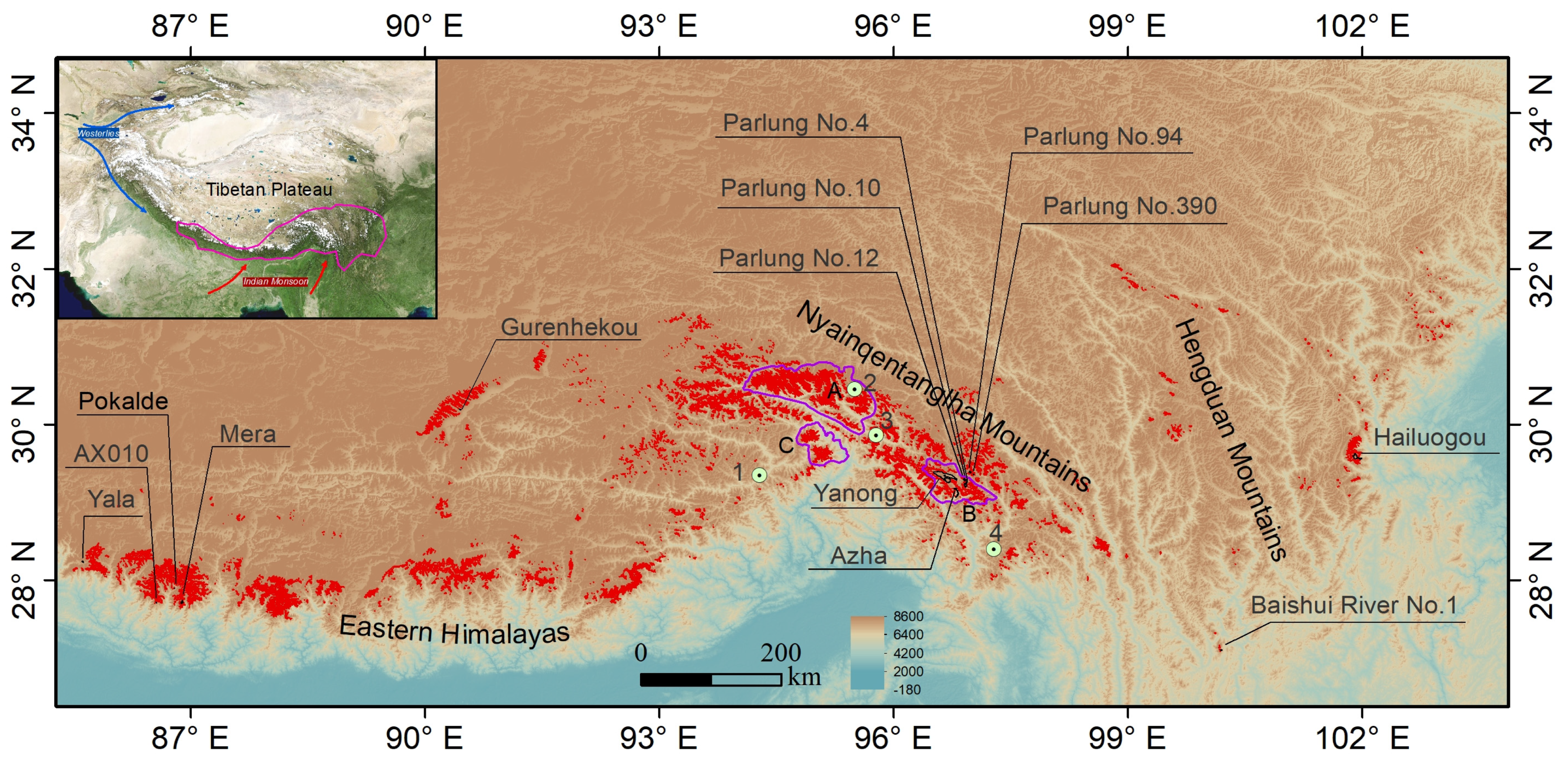


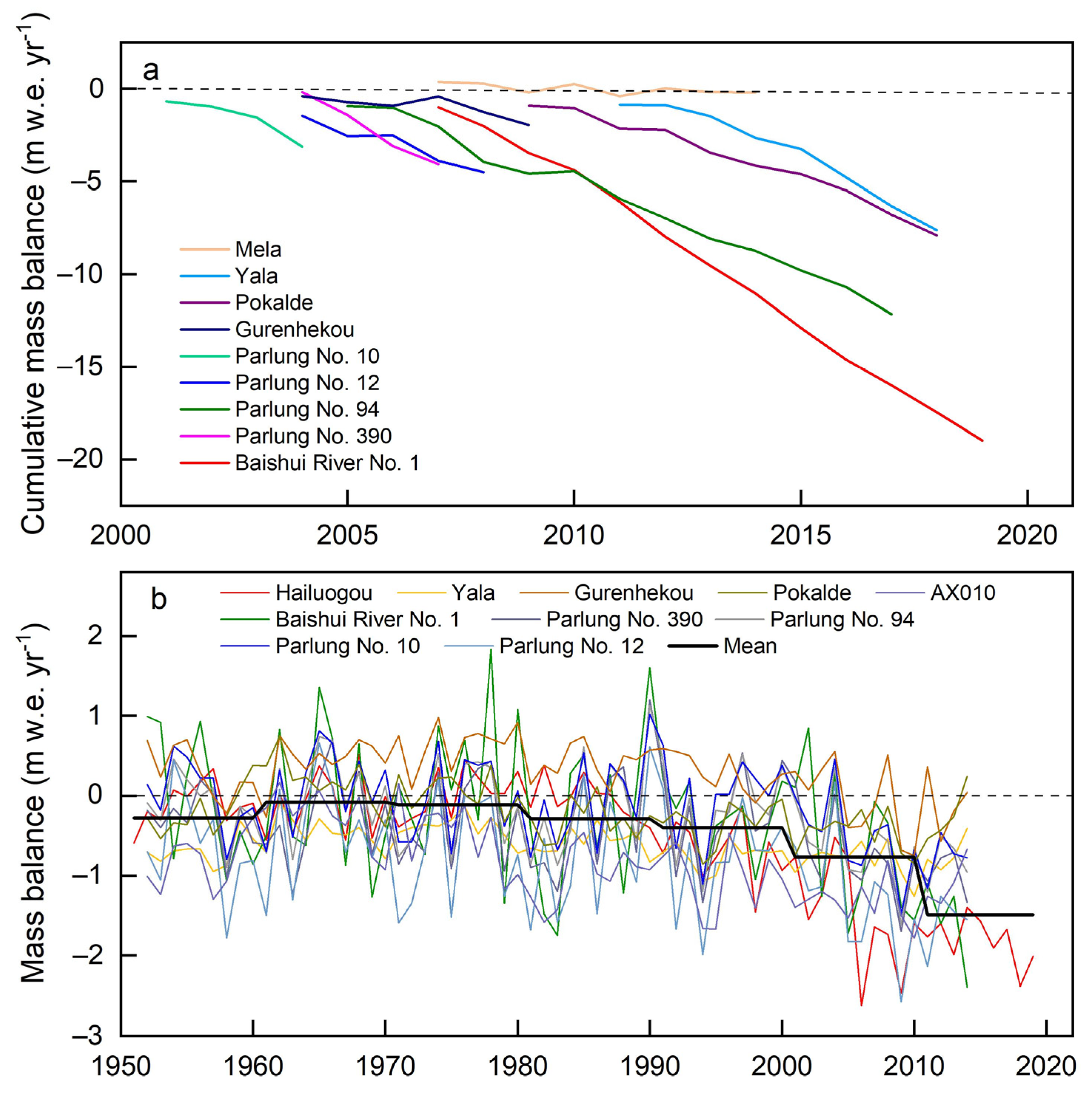
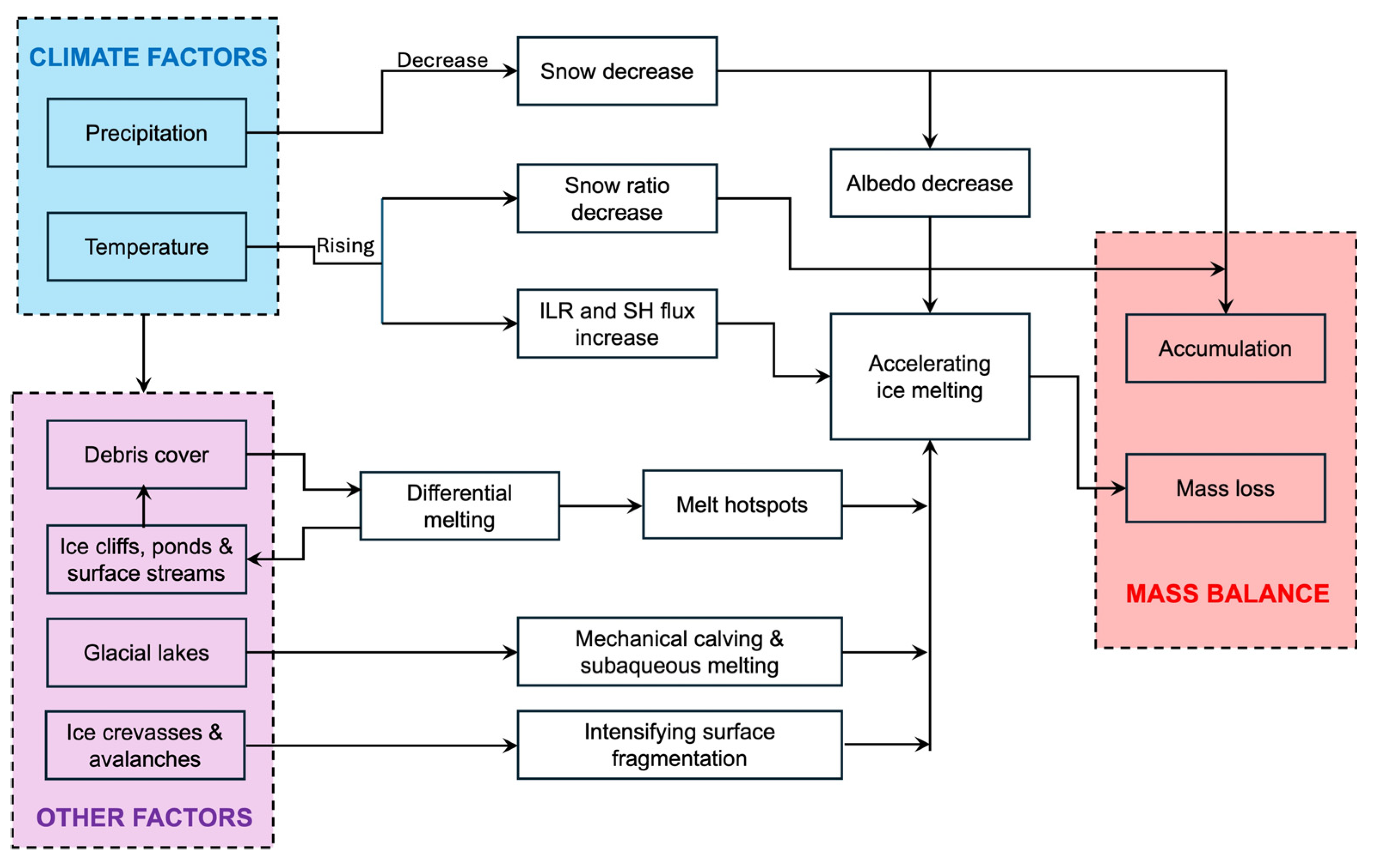
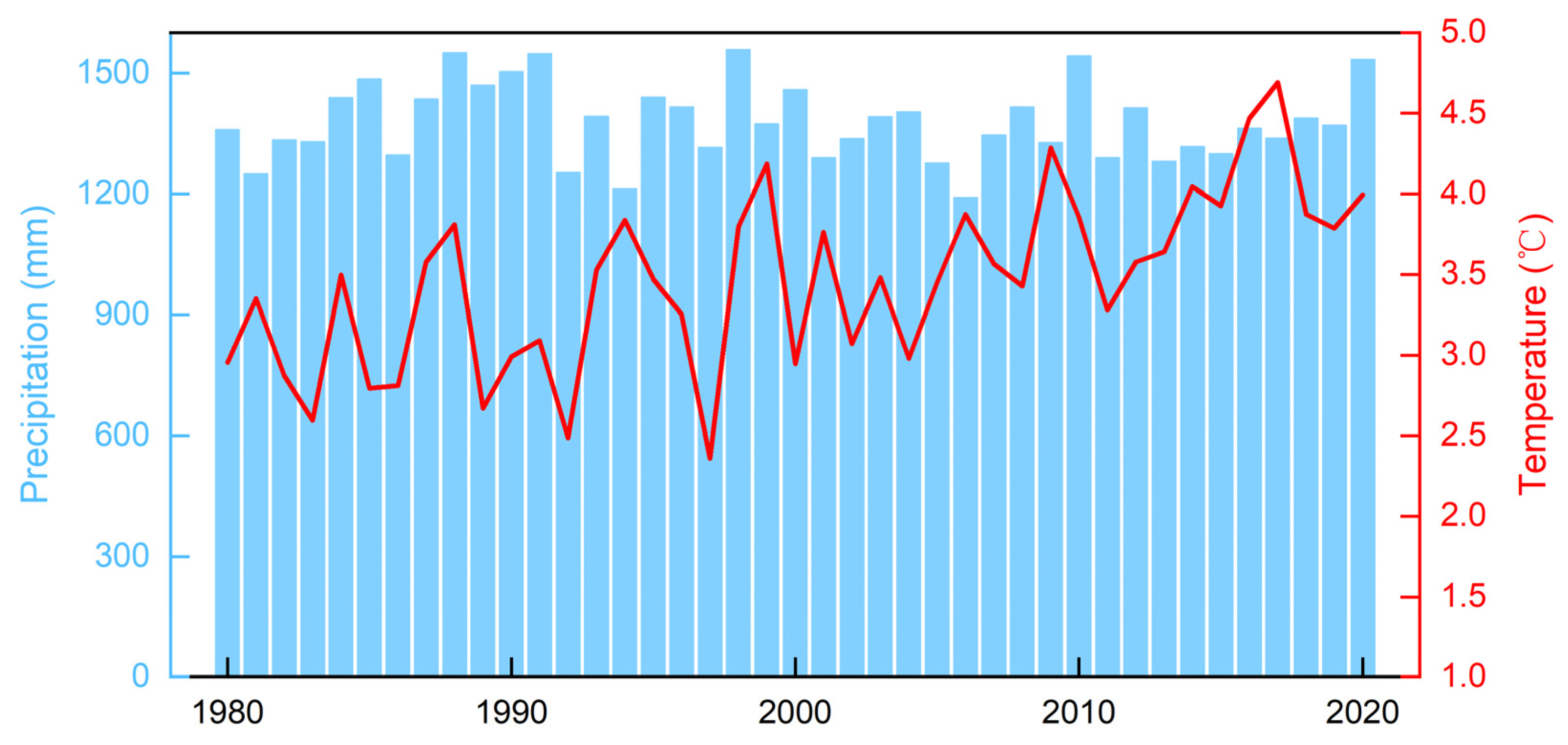
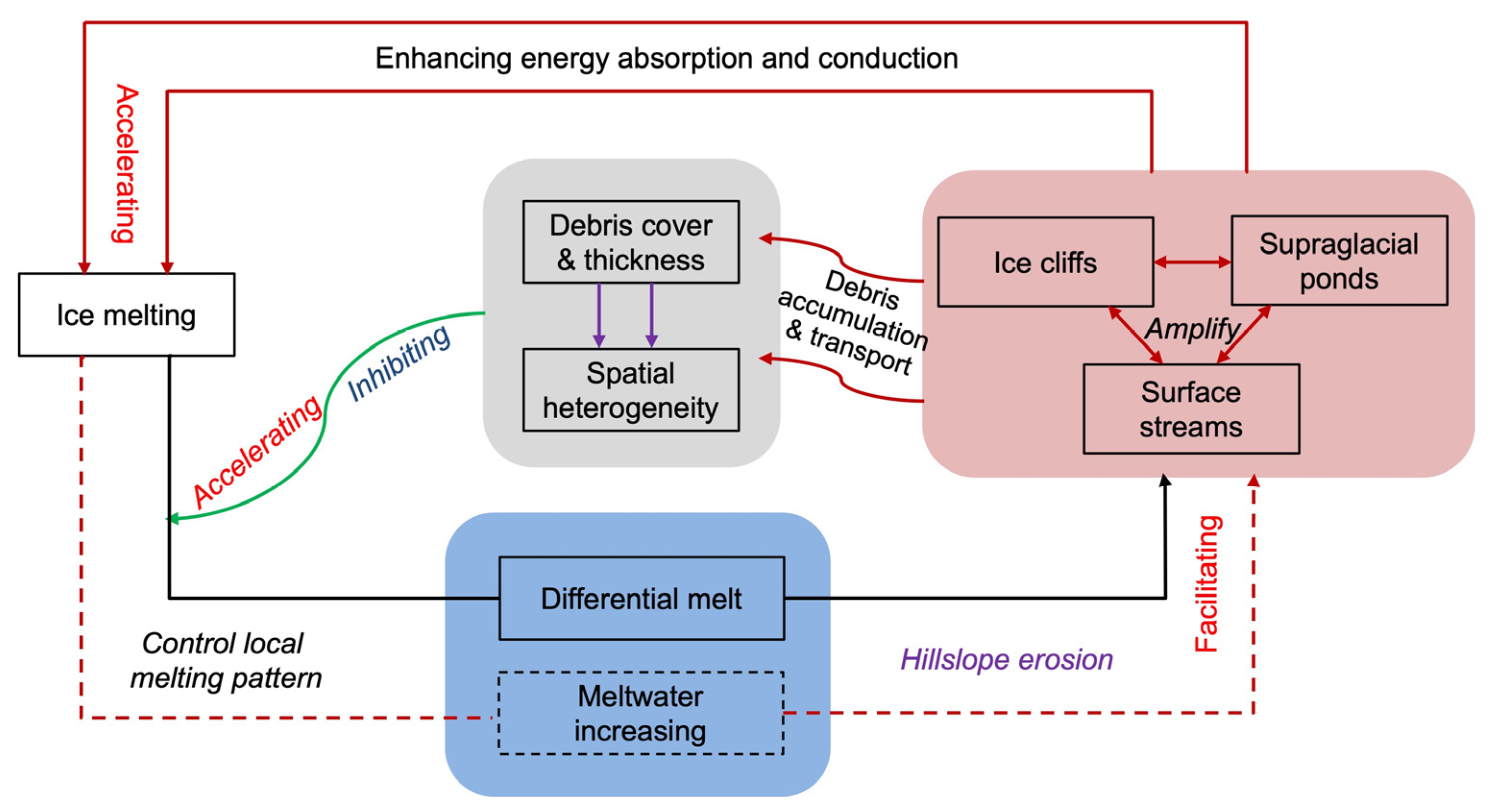

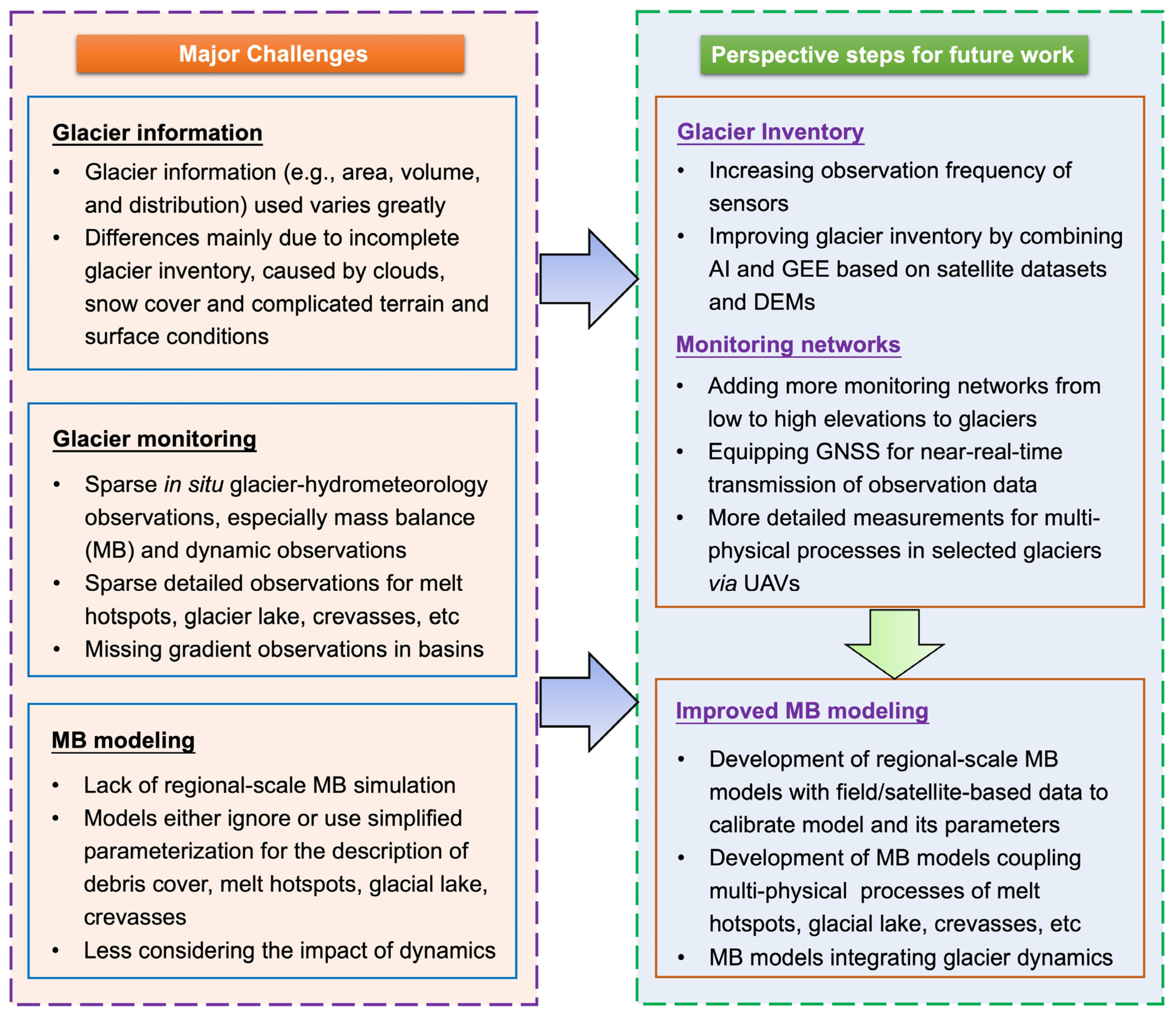
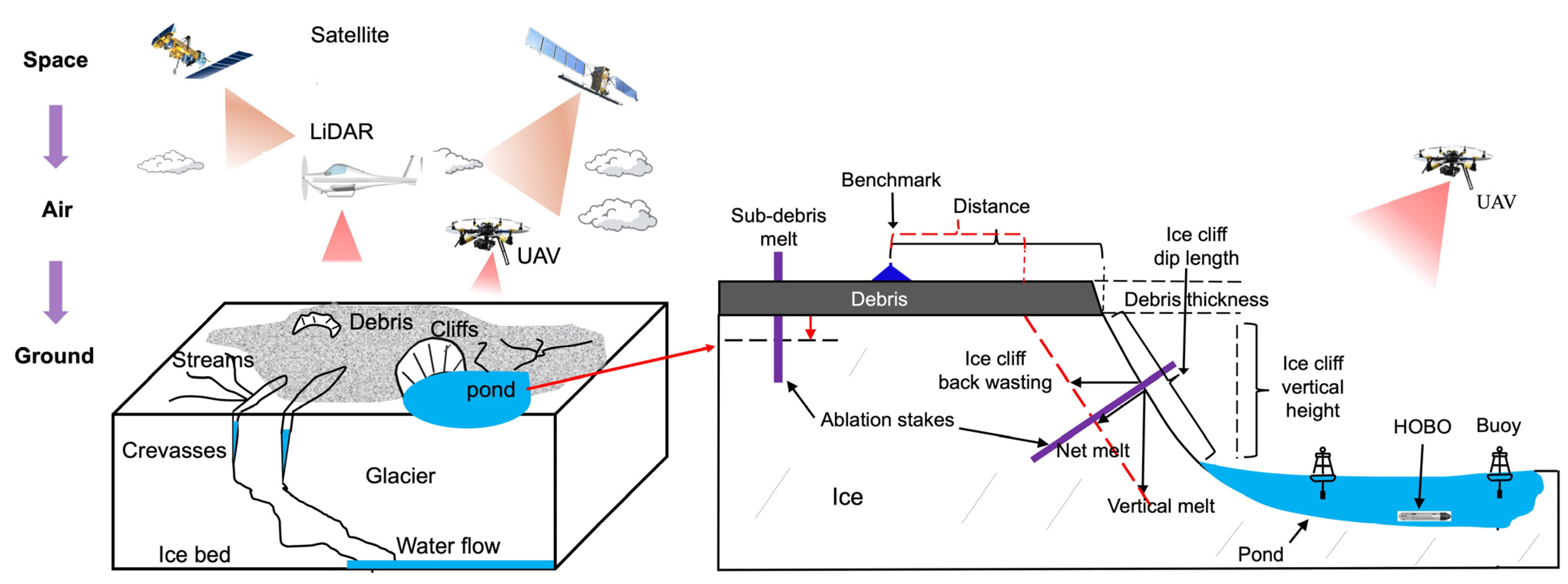
| Region | Elevation (m) | Glacier Number | Glacier Area (km2) | Proportion (%) | Average Area (km2) |
|---|---|---|---|---|---|
| Hengduan Mountains | 2979–7556 | 1725 | 1579.5 | 12.0 | 0.92 |
| Central and eastern Nyainqêntanglha | 2459–6930 | 4273 | 7888.8 | 59.7 | 1.85 |
| Eastern Himalayas | 3225–8798 | 2609 | 3734.9 | 28.3 | 1.43 |
| Total | 2459–8798 | 8607 | 13,203.2 | 100 | 1.53 |
| Period | Hengduan | Nyainqêntanglha | Eastern Himalayas | References |
|---|---|---|---|---|
| 2000–2020 | −0.71 ± 0.11 | −0.53 ± 0.10 | −0.52 ± 0.10 | [26] |
| 2000–2019 | −1.29 ± 0.32 | −0.84 ± 0.22 | −0.55 ± 0.14 | [25] |
| 2000–2018 | −0.64 ± 0.15 | −0.46 ± 0.14 | −0.52 ± 0.15 | [9] |
| 2000–2016 | −0.56 ± 0.23 | −0.62 ± 0.23 | −0.38 ± 0.20 | [8] |
| 2010–2019 | −0.92 ± 0.53 | −0.89 ± 0.19 | −0.69 ± 0.24 | [76] |
Disclaimer/Publisher’s Note: The statements, opinions and data contained in all publications are solely those of the individual author(s) and contributor(s) and not of MDPI and/or the editor(s). MDPI and/or the editor(s) disclaim responsibility for any injury to people or property resulting from any ideas, methods, instructions or products referred to in the content. |
© 2024 by the authors. Licensee MDPI, Basel, Switzerland. This article is an open access article distributed under the terms and conditions of the Creative Commons Attribution (CC BY) license (https://creativecommons.org/licenses/by/4.0/).
Share and Cite
Lyu, X.; Zhang, Y.; Wang, H.; Wang, X. Mass Balance of Maritime Glaciers in the Southeastern Tibetan Plateau during Recent Decades. Sustainability 2024, 16, 7118. https://doi.org/10.3390/su16167118
Lyu X, Zhang Y, Wang H, Wang X. Mass Balance of Maritime Glaciers in the Southeastern Tibetan Plateau during Recent Decades. Sustainability. 2024; 16(16):7118. https://doi.org/10.3390/su16167118
Chicago/Turabian StyleLyu, Xiaowei, Yong Zhang, Huanhuan Wang, and Xin Wang. 2024. "Mass Balance of Maritime Glaciers in the Southeastern Tibetan Plateau during Recent Decades" Sustainability 16, no. 16: 7118. https://doi.org/10.3390/su16167118
APA StyleLyu, X., Zhang, Y., Wang, H., & Wang, X. (2024). Mass Balance of Maritime Glaciers in the Southeastern Tibetan Plateau during Recent Decades. Sustainability, 16(16), 7118. https://doi.org/10.3390/su16167118







